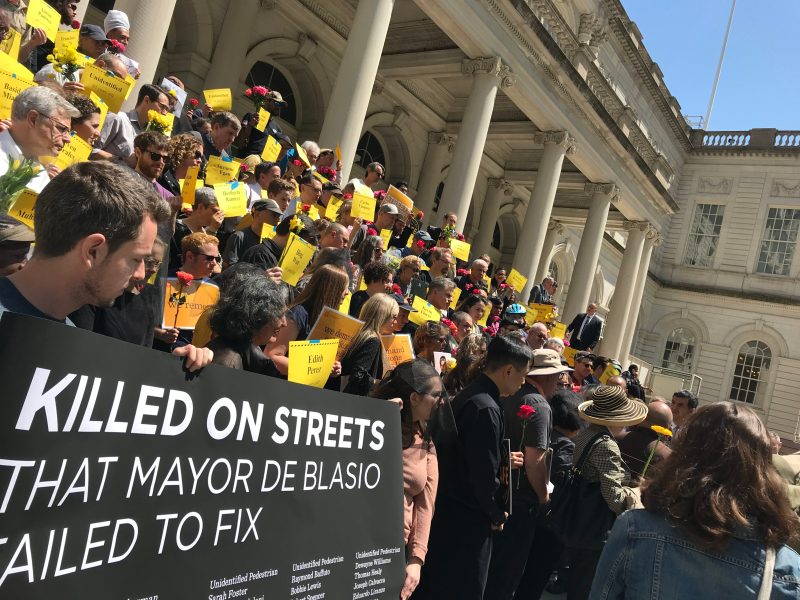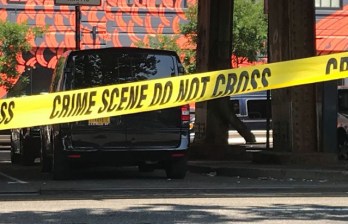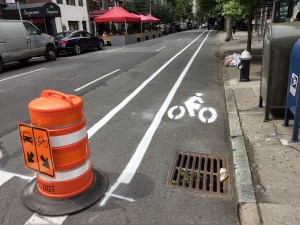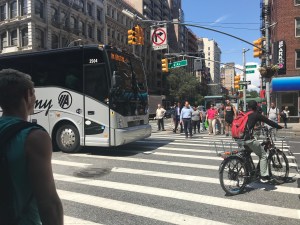Cyclists Are Not the Enemy, Says a Widow Whose Husband Was Killed By a Cyclist

Cyclists are not the problem — poor street design is, and it’s killing people.
Last week, Donna Sturm became the first pedestrian killed by someone riding a bike in New York City since 2017. The biker allegedly went through a red light and struck the 67-year-old in a Midtown crosswalk on April 24, sending her into a coma. She died on May 4.
The fatality was a devastating reminder for Hindy Schachter, whose husband Irving Schachter was killed in 2014 by a teen biker in Central Park — but she says it also reinforced the idea that the real threat on New York City’s streets is a culture that prioritizes cars over safety. It’s an argument she’s been making for five years.

“When I hear a story like this, my first thought is deep sympathy and empathy for the victim and the family. After that I think, ‘How can we make this the last tragedy of this sort.’ I know that the answer is going to be better street design allied with enforcement,” said Schachter, a member of Families for Safe Streets. “There are people who will talk about bad cyclists who whizz by them — sure let’s give that cyclist a ticket. But the issue is not the few cyclist fatalities, the issue is the fatalities as a whole, the vast majority of which come from motor vehicles, and the solution is a totally different way of designing streets.”
And the proof is in the numbers.
According to the city’s NYPD Motor Vehicle Collisions database, there were 45,775 motor vehicle collisions that resulted in injuries last year — 11,115 of those injuries were to pedestrians. Police say 230 of those pedestrians — just two percent — were struck and hurt by a bike rider, with the remaining 98 percent hurt by motorists. This year, at least 65 people have been killed by a driver — a 30-percent increase in fatalities compared to the same time period last year, according to NYPD data (the city DOT claims the percent increase is actually lower). One person — Sturm — has been killed by a cyclist.
Schachter recognizes that the individual cyclists who killed both her husband and Sturm are just as much at fault as any reckless motorist who kills someone. But demonizing those who ride bikes, who statistically cause a tiny fraction of all injury-causing collisions on the road, is not making anyone safer.
Instead, the city must invest its resources in redesigning streets that make it harder to kill someone, said Schachter.
“These incidents where a negligent, thoughtless cyclist kills a pedestrian are horrible for the people involved and a blight on the city, but they are very, very rare,” she said. “If you want safe streets, if you want to be able to walk around NYC and feel, ‘I’m okay in the crosswalks,’ worrying about bikes is not going to get you there. You’re never going to get a world with no negligent people — but we can do something about street redesign, we can change the city so it’s easier to walk and bicycle.”
According to the Department of Transportation, there are roughly 490,000 bike trips per day. Comparatively, the DOT counted about 4,441,000 daily car trips at borough and city boundaries in 2016. That means about .04 percent of cyclists on the road cause injuries to pedestrians, while .2 percent of car drivers do.
(The city does not know the total number of cars on the road, so the 4,441,000 does not include intra-borough trips. But even accounting for many more trips, cars still cause more injuries to pedestrians than cyclists do by a factor of 10. And car speeds and weights mean that many injuries become deaths.)
Cyclists did not kill a single person in New York City in 2018, while drivers killed 202.
But despite those numbers, critics paint cyclists as villains, and cops continue to target them. Mayor de Blasio also continues to defend his crackdown on e-bike riders — most of whom are low-wage immigrant delivery workers — despite the city’s own data that proves e-bike riders have caused even fewer injuries to pedestrians than cyclists overall. E-bike rides injured just nine of the 11,115 injured pedestrians last year, according to the city’s own data.
The mayor doubled down on his enforcement effort, saying on Brian Lehrer’s radio show on Friday morning that e-bikes are dangerous because they go “the wrong way down the street, a lot of speed at levels they shouldn’t be.” He then added, “Why don’t these businesses and these restaurants find another way to make their delivery rather than an e-bike?”
The timing was brutal; just days earlier, a candy truck driver hit and killed a 3-year-old boy in Brooklyn.
The only transportation question so far is some lady bemoaning about electronic bikes. “I have seen exactly what you’ve seen,” says the mayor about e-bikes on sidewalks. “If you are in a truck, a car, a motorcycle, you’re not going the wrong way on streets….
— Second Ave. Sagas (@2AvSagas) May 10, 2019
But it’s not just the mayor and law enforcement who seem to disproportionately bully bikers — pedestrians are reflexively more scared of cyclists than they are of cars, and often unleash that fear on social media or in op-eds printed in major daily newspapers.
People who ride Citi bikes with their headphones on … no helmet…and ignore all traffic rules… Can kill people. I don’t understand how New York City allows this. It’s wrong.
— Erin Burnett (@ErinBurnett) May 1, 2019
I think cycling is great and we need to move more city planning away from cars. My anti-cyclist rage is just based on their being feral and lawless in New York City and terrorizing pedestrians.
— Josh Marshall (@joshtpm) May 1, 2019
Howard Husock of the Manhattan Institute penned a Daily News op-ed demanding that cyclists “must do better” after Sturm was killed.
“Some cyclists in New York are posing a public safety risk,” Husock wrote.
Of course some cyclists misbehave, but Husock was fighting the wrong battle; advocates are not arguing for cyclists to blow through a red light or speed the wrong way down a block without punishment. But they are calling for changes that Husock did not even mention: the need for better road design would make it harder for everyone, including those who bike, to break traffic laws.
Critics of cycling often taunt bike riders by saying, “New York isn’t Amsterdam,” but the jibe reveals the essential problem: New York does not have Amsterdam’s cycling- and pedestrian-friendly road designs — if it did, there wouldn’t be more than 200 people killed on the streets every year.
But Amsterdman, like Copenhagen, wasn’t built in a day, as Bike New York’s Jon Orcutt told Streetsblog last week.
'Our city is not Amsterdam'.
Well, so wasn't Amsterdam: it took long, deliberate and consistent work.
And a conscious decision to change!~Zeilstraat, Amsterdam 1970s pic.twitter.com/svV4hfWnfv
— Cycling Professor ? ? (@fietsprofessor) May 12, 2019
Leaders of the Dutch city made the conscience decision in the 1970s to transition from its heavy reliance on cars to a more sustainable mode of transportation, like bikes. Cycling advocates formed a group, “Stop de Kindermoord (Stop the Child Murder)” after more than 400 kids had been killed in traffic crashes in 1971, according to The Guardian.
But the imperative to break Amsterdam’s car-dependance was also emboldened by the rising price of oil — the Dutch government started car-free Sundays in an effort to save energy. That culture change stuck and continued to grow, making Amsterdam one of the world’s leading cycling capitals.
New York could be too, if its leaders were as focused on creating the infrastructure for it.
“Anywhere and everywhere the city installs safe cycling infrastructure, injuries to all users go down,” said safe-street advocate Doug Gordon. “If we want better behavior from people, we just need better infrastructure. It’s as simple as that.”
Peter Walker of The Guardian continued his ground-breaking work with a video last week about the wrongheaded attacks on cyclists who break the law, citing the low risk they cause by doing so compared to drivers who break the law.
There’s a psychological reason behind the fear of cyclists, according to psychiatrist Anne Skomorowsky, a clinical instructor at Mount Sinai. Pedestrians interact on a closer and more personal level with cyclists — literally seeing them at eye level — as opposed to viewing a car as an inanimate object, she said.
“An interaction with a cyclist is a personal one rather than an interaction with someone in a machine that we cannot see. And interpersonal violence causes far more symptoms than natural tragedy,” she said. “One asshole cyclist is so disturbing that you can’t get it out of your mind for a long time. But a car cutting me off in the crosswalk, I forget about that a minute later.”
And the fact that there are way more cars on the road than there are bikes means one close encounter with a cyclist will stand out more in someone’s mind, said Skomorowsky.
“The volume is important, too. In a given day, I might see 10,000 cars. And I might see 80 people on bikes. So my experience of cars in general is that they’re well-behaved and won’t hurt me but my experience of bikes is that some get a little close,” she said. “It only takes one to make people feel that bicyclists are lunatics. It’s normal to be afraid of fast-moving objects.”
But the result is “misfearing,” a psychological term connected to people’s emotional reaction, Skomorowsky said — like women fearing breast cancer far more than they fear heart disease, even though heart disease is a far bigger killer of women.
The psychology behind being disproportionately scared of a bicycle still does not take away from the suffering of the Sturm and Schachter families. But personal psychology — and the political reaction to it — gets in the way of simply redesigning streets to make them safer so that cyclists — and motorists — are less likely to speed, less likely to be reckless, and less likely to kill someone, said Gordon.
“If you want to reign in bad behavior, you need to create better infrastructure, like protected bike lanes. It self-enforces people in them. It also helps pedestrians deal with unpredictability in the street, makes the street safer and more predictable,” he said.
Cyclists and pedestrians should not be pit against each other — they are both fighting for their lives against cars, said Schachter — who joined dozens of other victims’ families and safe-street advocates on Tuesday to declare that Vision Zero in a “State of Emergency” and to demand that de Blasio do more to stop the bloodshed.
“Both pedestrians and cyclists are woefully shortchanged in today’s allocation of space and we need to shift that, we need protected bike lanes and pedestrian islands,” said Schachter. “We need a culture that prioritizes safety.”
We don’t, unfortunately, live in that culture.
“For many of us, what it means to be American means that we drive cars,” said Skomorowsky, the psychiatrist. “And we drive cars to get to work and we just accept whatever risks come from car driving because we are Americans and we drive cars. Cars are for grown-ups for doing something important and bikes are toys, for kids, or for recreation and it’s not done by people who are doing anything important, not like using a car to get to work or feed your family by going to the store.”
Additional reporting by Gersh Kuntzman.


